Nursing Reflective Essay: IV Infusion Priming Skills Development
VerifiedAdded on 2023/06/13
|6
|1467
|405
Essay
AI Summary
This nursing reflective essay explores the process of priming an intravenous infusion line, inserting it into a pump, and programming the ml/hour calculation based on written orders. The reflection details the student's preparation for clinical placement, focusing on developing confidence and competence in accessing intravenous devices using aseptic non-touch techniques, medication safety principles, and infection control measures. The essay discusses the skills learned in class, including patient identification, fluid order verification, cannula site assessment, and adherence to the six rights of medication administration. The student reflects on their feelings of confidence and competence, while also acknowledging areas for improvement such as communication skills and time management. The essay concludes with an action plan for continued learning and skill refinement, emphasizing the importance of patient safety and effective documentation. The Gibbs model of reflection is used to thoroughly examine the event and explore feelings efficiently.
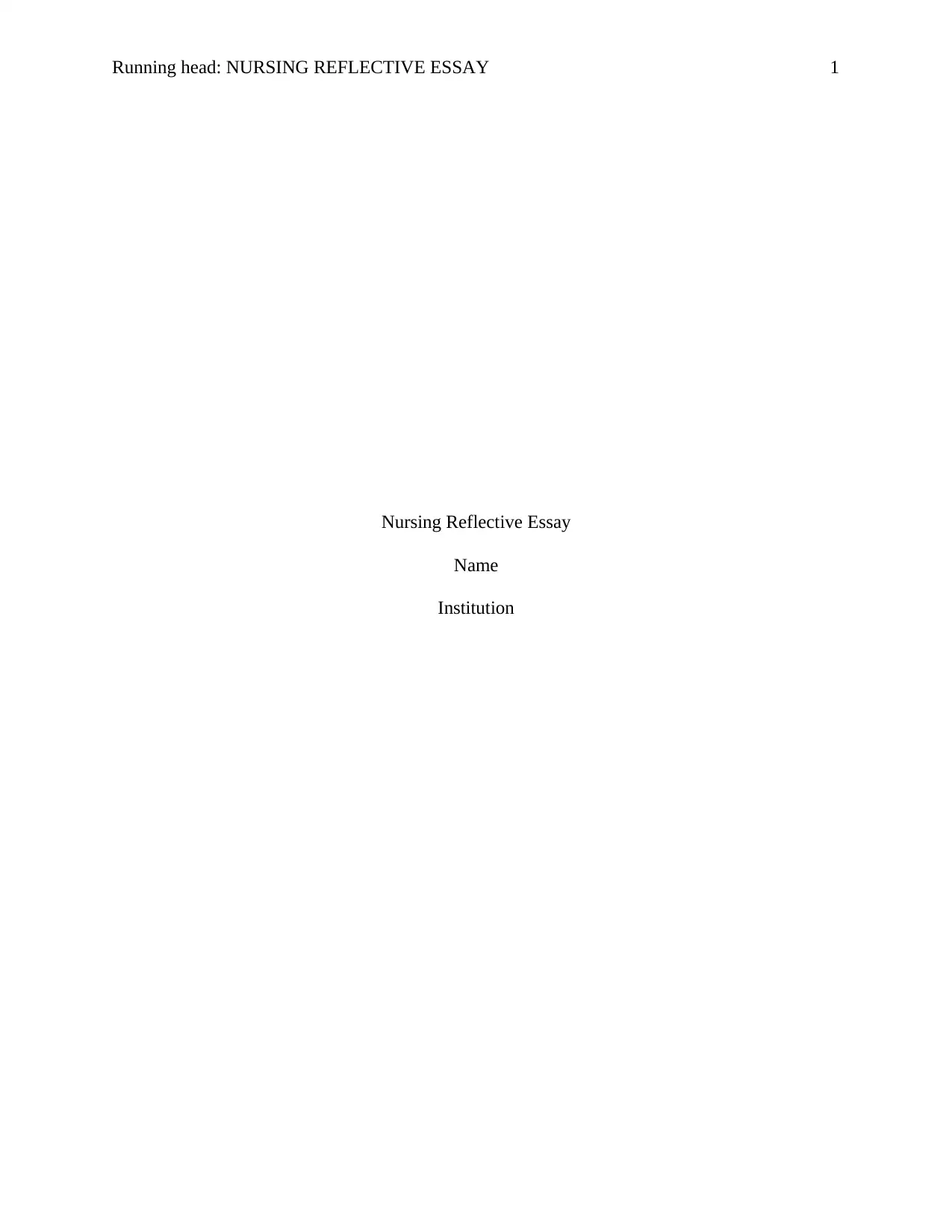
Running head: NURSING REFLECTIVE ESSAY 1
Nursing Reflective Essay
Name
Institution
Nursing Reflective Essay
Name
Institution
Paraphrase This Document
Need a fresh take? Get an instant paraphrase of this document with our AI Paraphraser
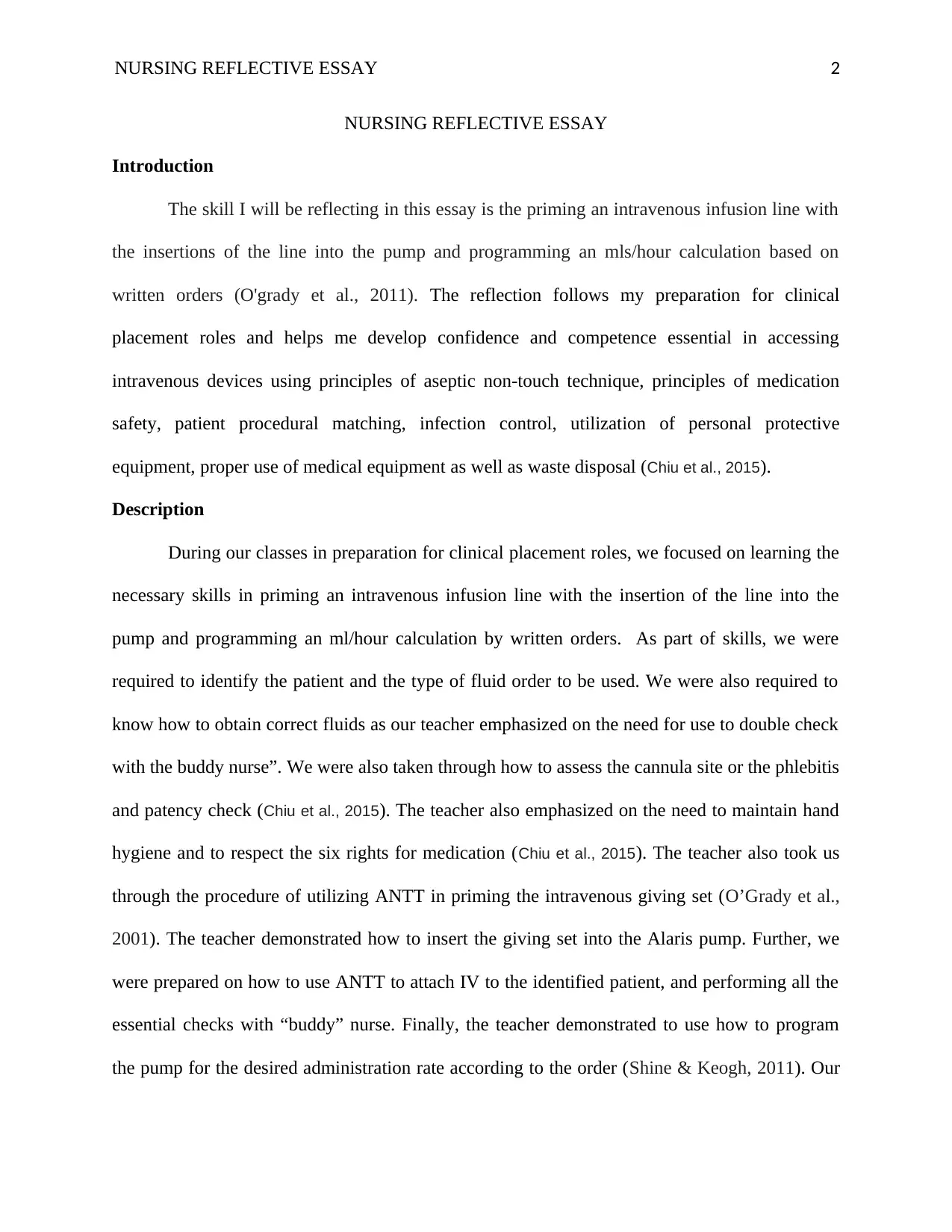
NURSING REFLECTIVE ESSAY 2
NURSING REFLECTIVE ESSAY
Introduction
The skill I will be reflecting in this essay is the priming an intravenous infusion line with
the insertions of the line into the pump and programming an mls/hour calculation based on
written orders (O'grady et al., 2011). The reflection follows my preparation for clinical
placement roles and helps me develop confidence and competence essential in accessing
intravenous devices using principles of aseptic non-touch technique, principles of medication
safety, patient procedural matching, infection control, utilization of personal protective
equipment, proper use of medical equipment as well as waste disposal (Chiu et al., 2015).
Description
During our classes in preparation for clinical placement roles, we focused on learning the
necessary skills in priming an intravenous infusion line with the insertion of the line into the
pump and programming an ml/hour calculation by written orders. As part of skills, we were
required to identify the patient and the type of fluid order to be used. We were also required to
know how to obtain correct fluids as our teacher emphasized on the need for use to double check
with the buddy nurse”. We were also taken through how to assess the cannula site or the phlebitis
and patency check (Chiu et al., 2015). The teacher also emphasized on the need to maintain hand
hygiene and to respect the six rights for medication (Chiu et al., 2015). The teacher also took us
through the procedure of utilizing ANTT in priming the intravenous giving set (O’Grady et al.,
2001). The teacher demonstrated how to insert the giving set into the Alaris pump. Further, we
were prepared on how to use ANTT to attach IV to the identified patient, and performing all the
essential checks with “buddy” nurse. Finally, the teacher demonstrated to use how to program
the pump for the desired administration rate according to the order (Shine & Keogh, 2011). Our
NURSING REFLECTIVE ESSAY
Introduction
The skill I will be reflecting in this essay is the priming an intravenous infusion line with
the insertions of the line into the pump and programming an mls/hour calculation based on
written orders (O'grady et al., 2011). The reflection follows my preparation for clinical
placement roles and helps me develop confidence and competence essential in accessing
intravenous devices using principles of aseptic non-touch technique, principles of medication
safety, patient procedural matching, infection control, utilization of personal protective
equipment, proper use of medical equipment as well as waste disposal (Chiu et al., 2015).
Description
During our classes in preparation for clinical placement roles, we focused on learning the
necessary skills in priming an intravenous infusion line with the insertion of the line into the
pump and programming an ml/hour calculation by written orders. As part of skills, we were
required to identify the patient and the type of fluid order to be used. We were also required to
know how to obtain correct fluids as our teacher emphasized on the need for use to double check
with the buddy nurse”. We were also taken through how to assess the cannula site or the phlebitis
and patency check (Chiu et al., 2015). The teacher also emphasized on the need to maintain hand
hygiene and to respect the six rights for medication (Chiu et al., 2015). The teacher also took us
through the procedure of utilizing ANTT in priming the intravenous giving set (O’Grady et al.,
2001). The teacher demonstrated how to insert the giving set into the Alaris pump. Further, we
were prepared on how to use ANTT to attach IV to the identified patient, and performing all the
essential checks with “buddy” nurse. Finally, the teacher demonstrated to use how to program
the pump for the desired administration rate according to the order (Shine & Keogh, 2011). Our
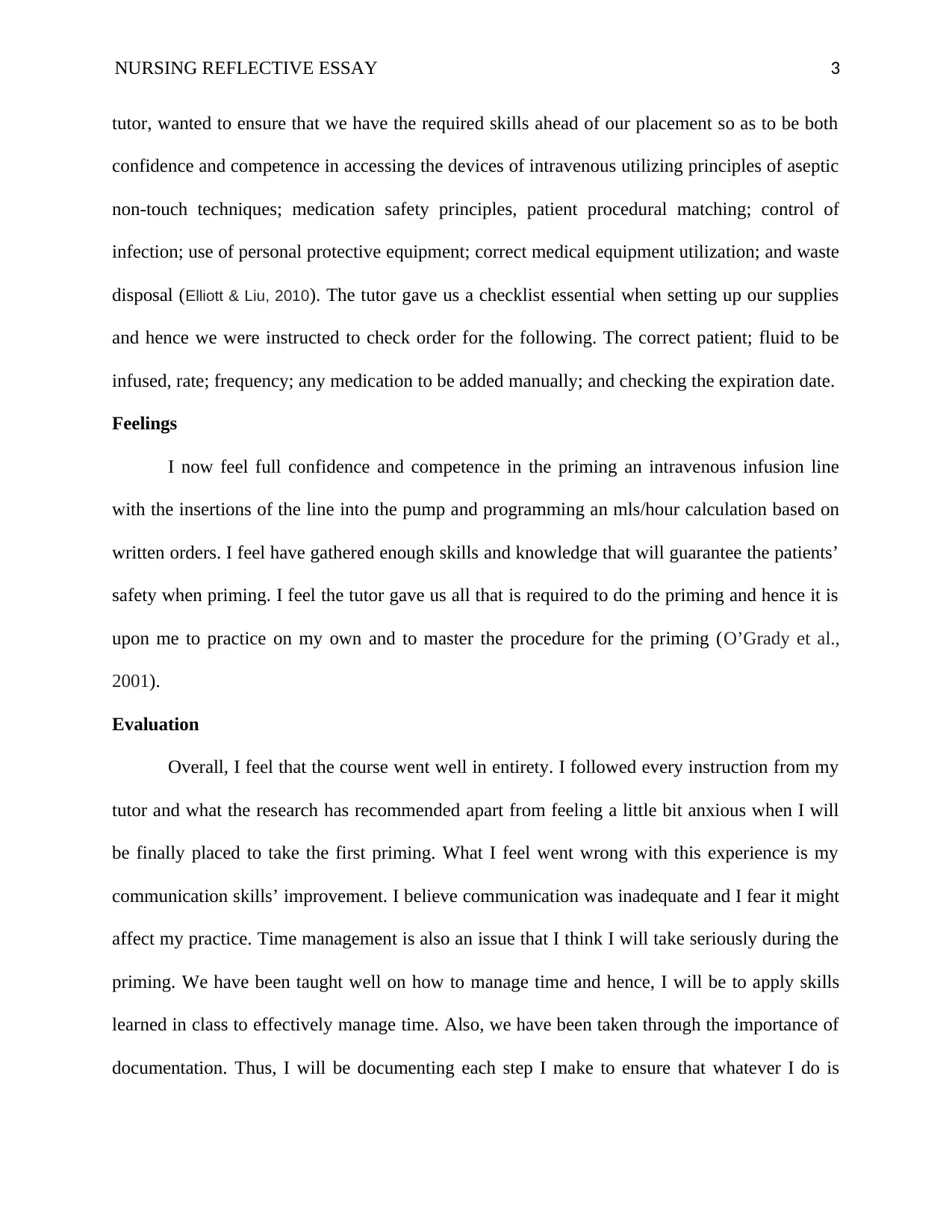
NURSING REFLECTIVE ESSAY 3
tutor, wanted to ensure that we have the required skills ahead of our placement so as to be both
confidence and competence in accessing the devices of intravenous utilizing principles of aseptic
non-touch techniques; medication safety principles, patient procedural matching; control of
infection; use of personal protective equipment; correct medical equipment utilization; and waste
disposal (Elliott & Liu, 2010). The tutor gave us a checklist essential when setting up our supplies
and hence we were instructed to check order for the following. The correct patient; fluid to be
infused, rate; frequency; any medication to be added manually; and checking the expiration date.
Feelings
I now feel full confidence and competence in the priming an intravenous infusion line
with the insertions of the line into the pump and programming an mls/hour calculation based on
written orders. I feel have gathered enough skills and knowledge that will guarantee the patients’
safety when priming. I feel the tutor gave us all that is required to do the priming and hence it is
upon me to practice on my own and to master the procedure for the priming (O’Grady et al.,
2001).
Evaluation
Overall, I feel that the course went well in entirety. I followed every instruction from my
tutor and what the research has recommended apart from feeling a little bit anxious when I will
be finally placed to take the first priming. What I feel went wrong with this experience is my
communication skills’ improvement. I believe communication was inadequate and I fear it might
affect my practice. Time management is also an issue that I think I will take seriously during the
priming. We have been taught well on how to manage time and hence, I will be to apply skills
learned in class to effectively manage time. Also, we have been taken through the importance of
documentation. Thus, I will be documenting each step I make to ensure that whatever I do is
tutor, wanted to ensure that we have the required skills ahead of our placement so as to be both
confidence and competence in accessing the devices of intravenous utilizing principles of aseptic
non-touch techniques; medication safety principles, patient procedural matching; control of
infection; use of personal protective equipment; correct medical equipment utilization; and waste
disposal (Elliott & Liu, 2010). The tutor gave us a checklist essential when setting up our supplies
and hence we were instructed to check order for the following. The correct patient; fluid to be
infused, rate; frequency; any medication to be added manually; and checking the expiration date.
Feelings
I now feel full confidence and competence in the priming an intravenous infusion line
with the insertions of the line into the pump and programming an mls/hour calculation based on
written orders. I feel have gathered enough skills and knowledge that will guarantee the patients’
safety when priming. I feel the tutor gave us all that is required to do the priming and hence it is
upon me to practice on my own and to master the procedure for the priming (O’Grady et al.,
2001).
Evaluation
Overall, I feel that the course went well in entirety. I followed every instruction from my
tutor and what the research has recommended apart from feeling a little bit anxious when I will
be finally placed to take the first priming. What I feel went wrong with this experience is my
communication skills’ improvement. I believe communication was inadequate and I fear it might
affect my practice. Time management is also an issue that I think I will take seriously during the
priming. We have been taught well on how to manage time and hence, I will be to apply skills
learned in class to effectively manage time. Also, we have been taken through the importance of
documentation. Thus, I will be documenting each step I make to ensure that whatever I do is
⊘ This is a preview!⊘
Do you want full access?
Subscribe today to unlock all pages.

Trusted by 1+ million students worldwide
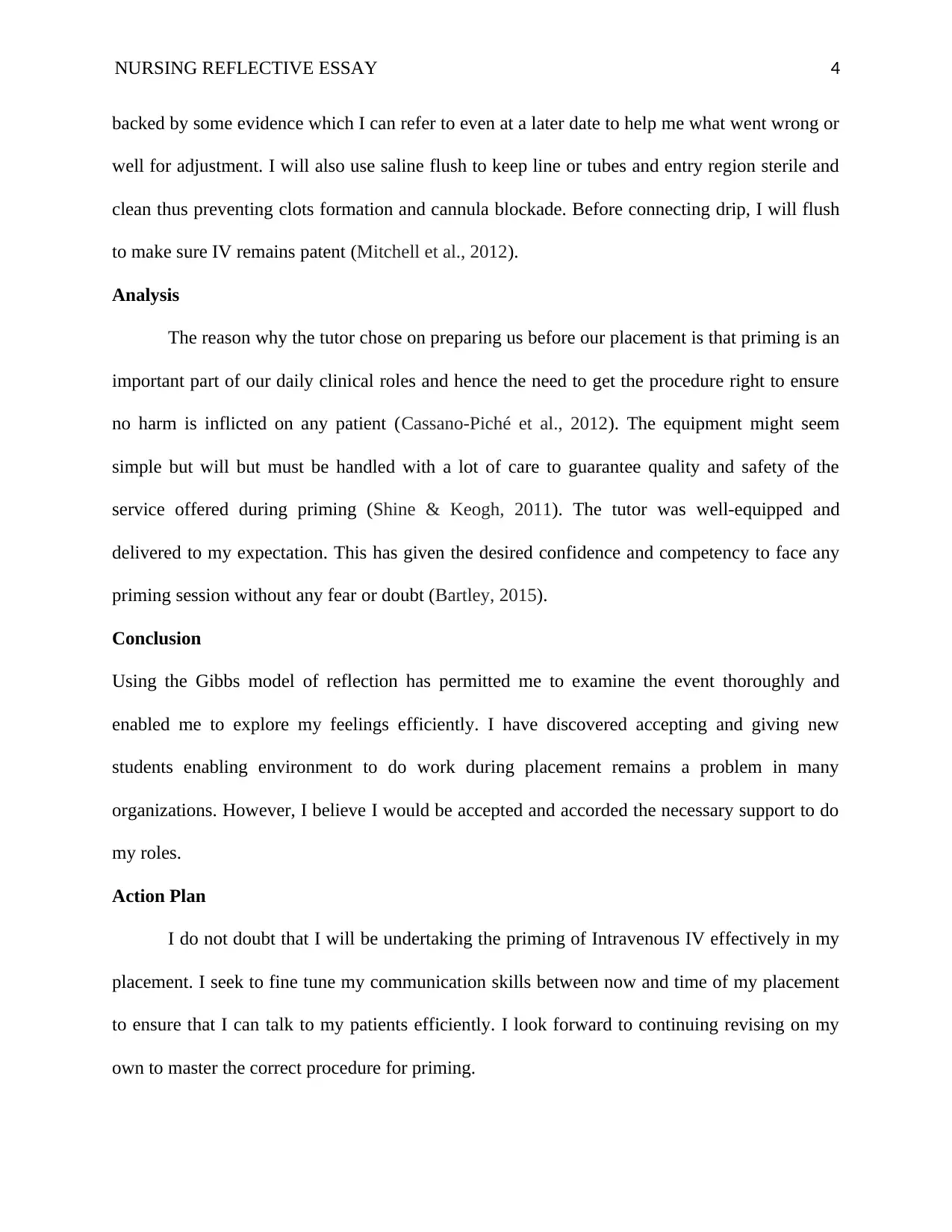
NURSING REFLECTIVE ESSAY 4
backed by some evidence which I can refer to even at a later date to help me what went wrong or
well for adjustment. I will also use saline flush to keep line or tubes and entry region sterile and
clean thus preventing clots formation and cannula blockade. Before connecting drip, I will flush
to make sure IV remains patent (Mitchell et al., 2012).
Analysis
The reason why the tutor chose on preparing us before our placement is that priming is an
important part of our daily clinical roles and hence the need to get the procedure right to ensure
no harm is inflicted on any patient (Cassano-Piché et al., 2012). The equipment might seem
simple but will but must be handled with a lot of care to guarantee quality and safety of the
service offered during priming (Shine & Keogh, 2011). The tutor was well-equipped and
delivered to my expectation. This has given the desired confidence and competency to face any
priming session without any fear or doubt (Bartley, 2015).
Conclusion
Using the Gibbs model of reflection has permitted me to examine the event thoroughly and
enabled me to explore my feelings efficiently. I have discovered accepting and giving new
students enabling environment to do work during placement remains a problem in many
organizations. However, I believe I would be accepted and accorded the necessary support to do
my roles.
Action Plan
I do not doubt that I will be undertaking the priming of Intravenous IV effectively in my
placement. I seek to fine tune my communication skills between now and time of my placement
to ensure that I can talk to my patients efficiently. I look forward to continuing revising on my
own to master the correct procedure for priming.
backed by some evidence which I can refer to even at a later date to help me what went wrong or
well for adjustment. I will also use saline flush to keep line or tubes and entry region sterile and
clean thus preventing clots formation and cannula blockade. Before connecting drip, I will flush
to make sure IV remains patent (Mitchell et al., 2012).
Analysis
The reason why the tutor chose on preparing us before our placement is that priming is an
important part of our daily clinical roles and hence the need to get the procedure right to ensure
no harm is inflicted on any patient (Cassano-Piché et al., 2012). The equipment might seem
simple but will but must be handled with a lot of care to guarantee quality and safety of the
service offered during priming (Shine & Keogh, 2011). The tutor was well-equipped and
delivered to my expectation. This has given the desired confidence and competency to face any
priming session without any fear or doubt (Bartley, 2015).
Conclusion
Using the Gibbs model of reflection has permitted me to examine the event thoroughly and
enabled me to explore my feelings efficiently. I have discovered accepting and giving new
students enabling environment to do work during placement remains a problem in many
organizations. However, I believe I would be accepted and accorded the necessary support to do
my roles.
Action Plan
I do not doubt that I will be undertaking the priming of Intravenous IV effectively in my
placement. I seek to fine tune my communication skills between now and time of my placement
to ensure that I can talk to my patients efficiently. I look forward to continuing revising on my
own to master the correct procedure for priming.
Paraphrase This Document
Need a fresh take? Get an instant paraphrase of this document with our AI Paraphraser
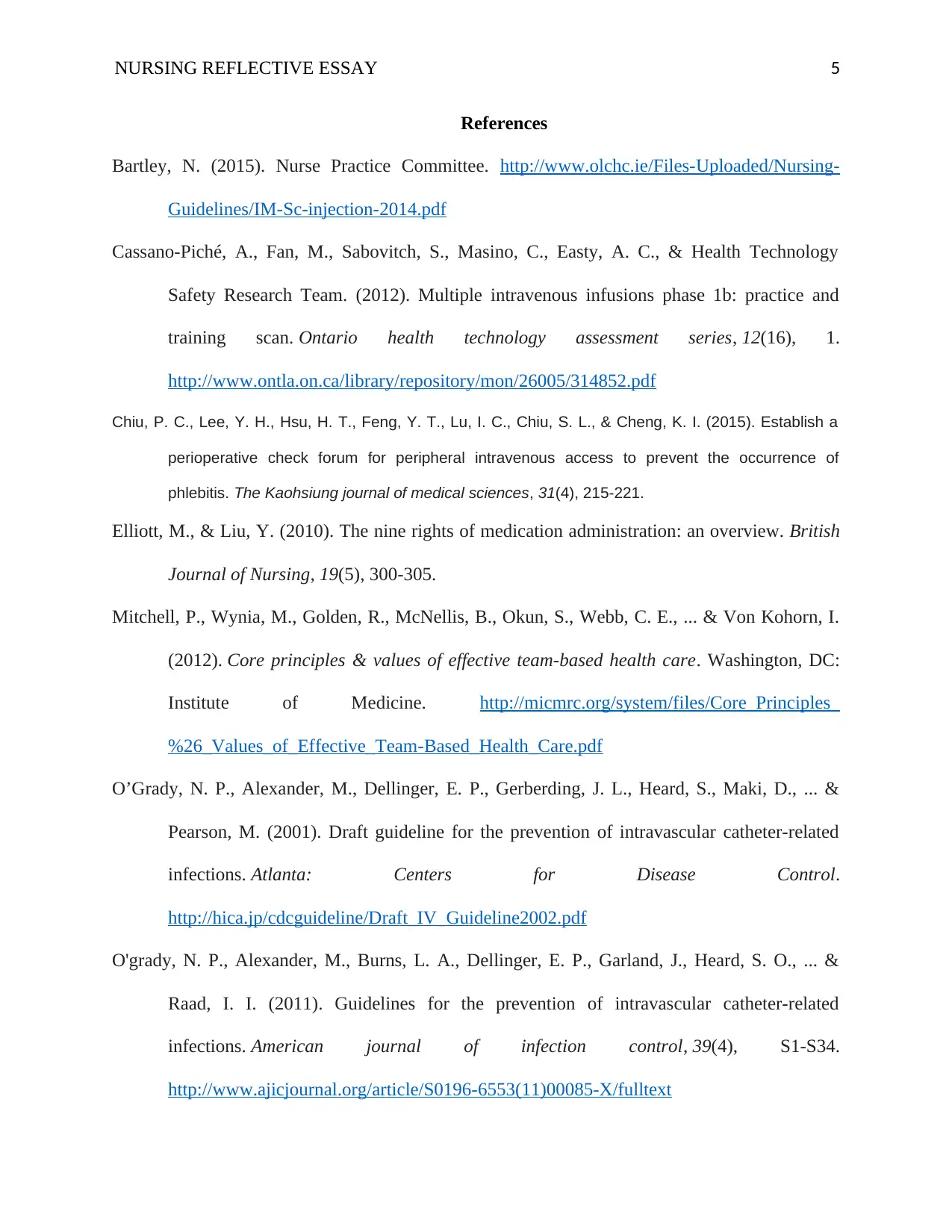
NURSING REFLECTIVE ESSAY 5
References
Bartley, N. (2015). Nurse Practice Committee. http://www.olchc.ie/Files-Uploaded/Nursing-
Guidelines/IM-Sc-injection-2014.pdf
Cassano-Piché, A., Fan, M., Sabovitch, S., Masino, C., Easty, A. C., & Health Technology
Safety Research Team. (2012). Multiple intravenous infusions phase 1b: practice and
training scan. Ontario health technology assessment series, 12(16), 1.
http://www.ontla.on.ca/library/repository/mon/26005/314852.pdf
Chiu, P. C., Lee, Y. H., Hsu, H. T., Feng, Y. T., Lu, I. C., Chiu, S. L., & Cheng, K. I. (2015). Establish a
perioperative check forum for peripheral intravenous access to prevent the occurrence of
phlebitis. The Kaohsiung journal of medical sciences, 31(4), 215-221.
Elliott, M., & Liu, Y. (2010). The nine rights of medication administration: an overview. British
Journal of Nursing, 19(5), 300-305.
Mitchell, P., Wynia, M., Golden, R., McNellis, B., Okun, S., Webb, C. E., ... & Von Kohorn, I.
(2012). Core principles & values of effective team-based health care. Washington, DC:
Institute of Medicine. http://micmrc.org/system/files/Core_Principles_
%26_Values_of_Effective_Team-Based_Health_Care.pdf
O’Grady, N. P., Alexander, M., Dellinger, E. P., Gerberding, J. L., Heard, S., Maki, D., ... &
Pearson, M. (2001). Draft guideline for the prevention of intravascular catheter-related
infections. Atlanta: Centers for Disease Control.
http://hica.jp/cdcguideline/Draft_IV_Guideline2002.pdf
O'grady, N. P., Alexander, M., Burns, L. A., Dellinger, E. P., Garland, J., Heard, S. O., ... &
Raad, I. I. (2011). Guidelines for the prevention of intravascular catheter-related
infections. American journal of infection control, 39(4), S1-S34.
http://www.ajicjournal.org/article/S0196-6553(11)00085-X/fulltext
References
Bartley, N. (2015). Nurse Practice Committee. http://www.olchc.ie/Files-Uploaded/Nursing-
Guidelines/IM-Sc-injection-2014.pdf
Cassano-Piché, A., Fan, M., Sabovitch, S., Masino, C., Easty, A. C., & Health Technology
Safety Research Team. (2012). Multiple intravenous infusions phase 1b: practice and
training scan. Ontario health technology assessment series, 12(16), 1.
http://www.ontla.on.ca/library/repository/mon/26005/314852.pdf
Chiu, P. C., Lee, Y. H., Hsu, H. T., Feng, Y. T., Lu, I. C., Chiu, S. L., & Cheng, K. I. (2015). Establish a
perioperative check forum for peripheral intravenous access to prevent the occurrence of
phlebitis. The Kaohsiung journal of medical sciences, 31(4), 215-221.
Elliott, M., & Liu, Y. (2010). The nine rights of medication administration: an overview. British
Journal of Nursing, 19(5), 300-305.
Mitchell, P., Wynia, M., Golden, R., McNellis, B., Okun, S., Webb, C. E., ... & Von Kohorn, I.
(2012). Core principles & values of effective team-based health care. Washington, DC:
Institute of Medicine. http://micmrc.org/system/files/Core_Principles_
%26_Values_of_Effective_Team-Based_Health_Care.pdf
O’Grady, N. P., Alexander, M., Dellinger, E. P., Gerberding, J. L., Heard, S., Maki, D., ... &
Pearson, M. (2001). Draft guideline for the prevention of intravascular catheter-related
infections. Atlanta: Centers for Disease Control.
http://hica.jp/cdcguideline/Draft_IV_Guideline2002.pdf
O'grady, N. P., Alexander, M., Burns, L. A., Dellinger, E. P., Garland, J., Heard, S. O., ... &
Raad, I. I. (2011). Guidelines for the prevention of intravascular catheter-related
infections. American journal of infection control, 39(4), S1-S34.
http://www.ajicjournal.org/article/S0196-6553(11)00085-X/fulltext
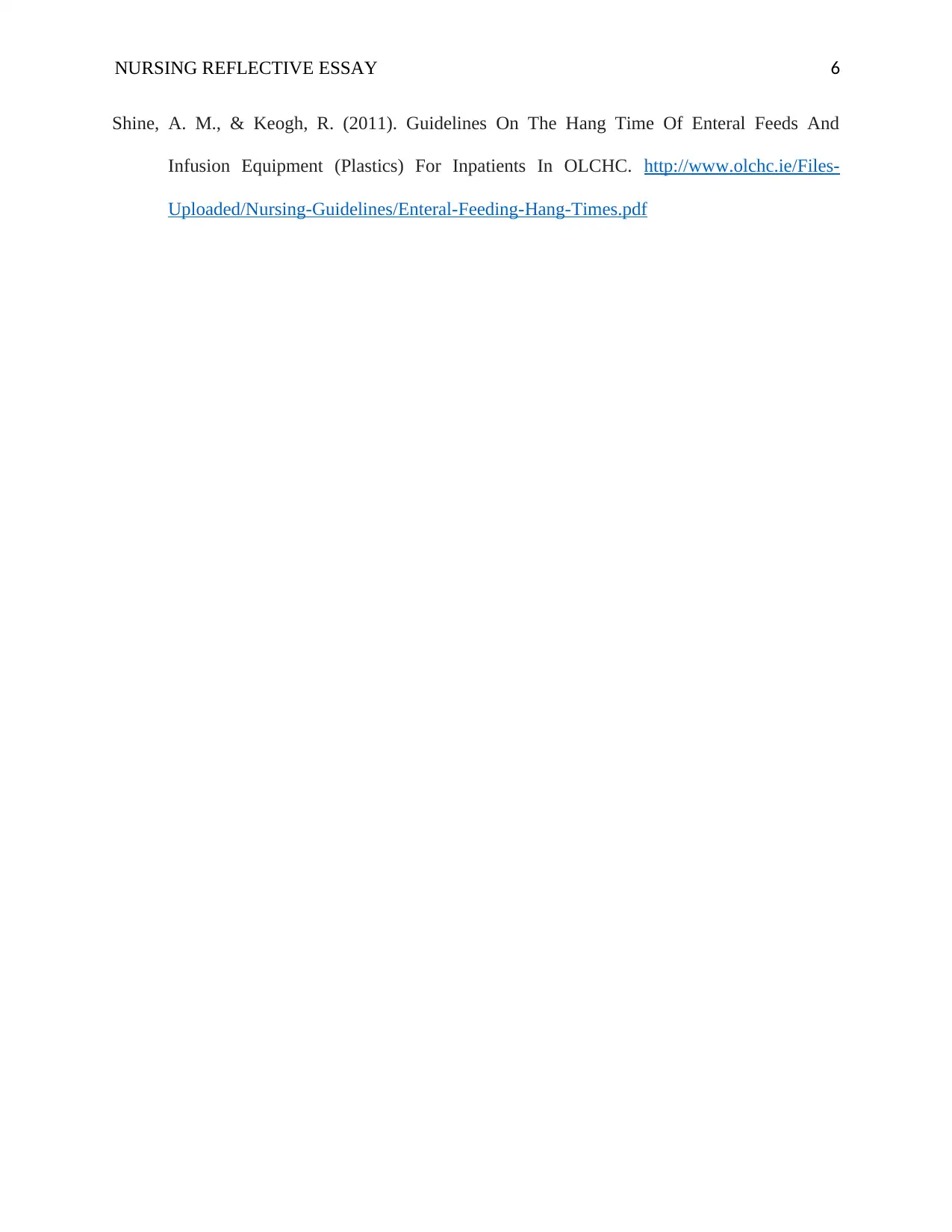
NURSING REFLECTIVE ESSAY 6
Shine, A. M., & Keogh, R. (2011). Guidelines On The Hang Time Of Enteral Feeds And
Infusion Equipment (Plastics) For Inpatients In OLCHC. http://www.olchc.ie/Files-
Uploaded/Nursing-Guidelines/Enteral-Feeding-Hang-Times.pdf
Shine, A. M., & Keogh, R. (2011). Guidelines On The Hang Time Of Enteral Feeds And
Infusion Equipment (Plastics) For Inpatients In OLCHC. http://www.olchc.ie/Files-
Uploaded/Nursing-Guidelines/Enteral-Feeding-Hang-Times.pdf
⊘ This is a preview!⊘
Do you want full access?
Subscribe today to unlock all pages.

Trusted by 1+ million students worldwide
1 out of 6
Your All-in-One AI-Powered Toolkit for Academic Success.
+13062052269
info@desklib.com
Available 24*7 on WhatsApp / Email
![[object Object]](/_next/static/media/star-bottom.7253800d.svg)
Unlock your academic potential
Copyright © 2020–2025 A2Z Services. All Rights Reserved. Developed and managed by ZUCOL.

